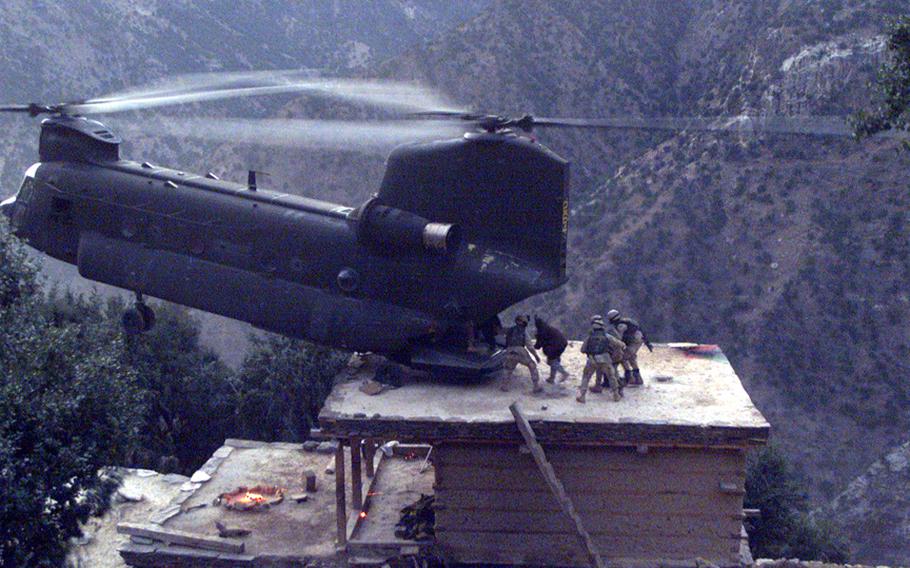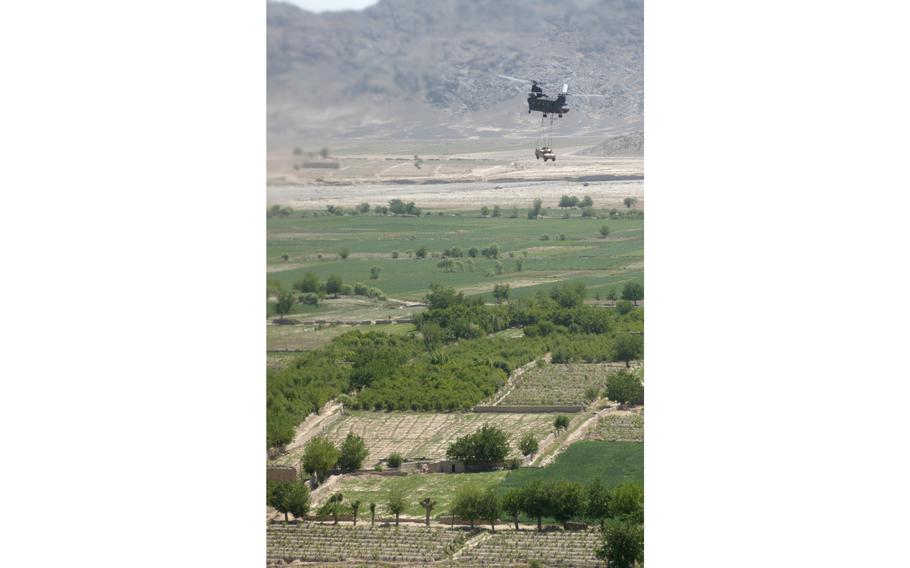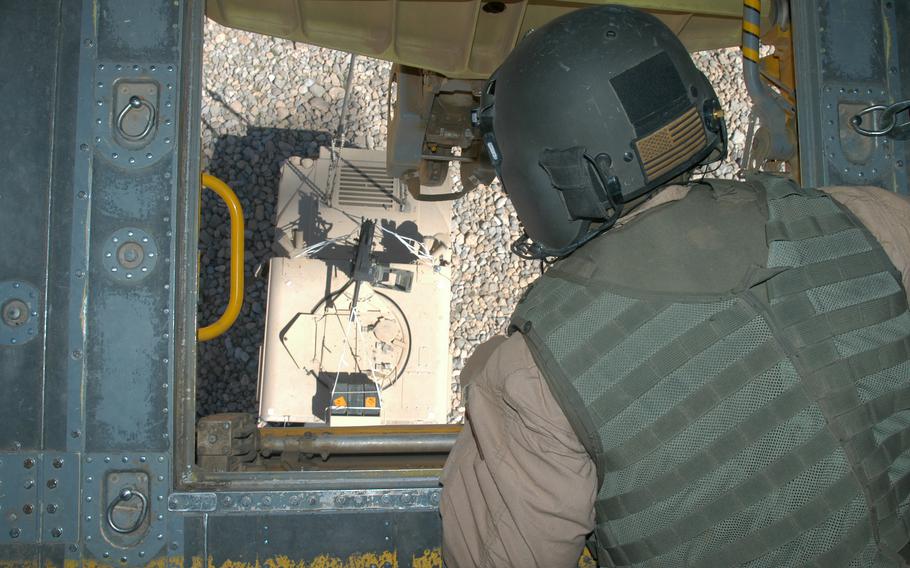
A CH-47D Chinook flown by Chief Warrant Officer 3 Larry Murphy rests its rear wheels on a house during Operation Mountain Resolve in Nuristan Province, Nov. 10, 2003, as they re-supply troops. The rest of the Chinook crew was Chief Warrant Officer 4 Paul Barnes, Sgt. 1st Class Jim Duggan, Sgt. Brian Kilburn and Spc. Margaret Haydeck. Many of the areas where the Chinooks fly don’t have traditional helicopter landing pads. (U.S. Army)
KANDAHAR AIRFIELD, Afghanistan — Flying is always a challenge in Afghanistan: The terrain is rugged and the weather severe. Yet the main mode of transportation for military forces is by helicopter.
It takes strong soldiers with a strong aircraft to succeed here.
The Nomads of Company G, 104th Aviation Regiment have had more than the weather and terrain to overcome since being mobilized early last year for Operation Iraqi Freedom.
One of the biggest challenges the nearly 200 Connecticut and Pennsylvania National Guard soldiers faced was a last-minute shift from the rolling deserts of Kuwait to the mountainous deserts of Afghanistan.
Now in their final few weeks before turning over their 14 CH-47D Chinook helicopters to Georgia and Alabama National Guard pilots, the Nomads can proudly look back at their 10 months of service.
“I’m bringing everybody home and that’s the most important thing,” said Maj. David Wood, Nomad company commander.
During their time in Afghanistan, the unit has flown more than 25,000 passengers, ranging from video camera-toting reporters to rocket propelled grenade-carrying Afghan National Army soldiers.
They’ve also hauled 8 3/4 million pounds of cargo — either internally or slung below the aircraft — between major bases and far-off outposts, a few of which don’t technically have helicopter landing sites.
All told, their Chinooks have flown more than 4,600 hours without major mishap or personnel injury.

A CH-47D Chinook from Company G, 104th Aviation Regiment flies over an Afghan farm as it delivers a sling-loaded Humvee from Kandahar to a firebase at Deh Rawood. During their 10 months in Afghanistan in 2003-2004 the crew has flown more than 8 ¾ million pounds of cargo either in its helicopter or slung underneath. (Jason Chudy/Stars and Stripes)
These statistics have earned them recognition as the National Guard recipient of the 2003 Outstanding Army Aviation Unit of the Year Award.
It also brings them praise from operational commanders.
“What they bring to Afghanistan is experience because they’re Guardsmen,” said Lt. Col. Orlando Lopez, Task Force Knighthawk commander. “Their experience ... allows them to fly their aircraft at maximum capabilities where a less experienced pilot may not be able to.”
Nomad pilots average about 3,000 flying hours each, compared, they say, to about 750 for their active-duty counterparts. Even many of the aircraft crewmembers have more than 1,000 hours of flight time.
Chief Warrant Officer 4 Rich Curadi flew Apaches during the first Gulf War and two of the unit’s pilots flew helicopters in Vietnam.
“They truly are citizen-soldiers, making not just one sacrifice,” Wood said. “They are professionals — VPs of ‘Fortune 500’ companies, self-employed contractors, electrical engineers, school teachers, and we’ve got a lot of students.”
The Nomads are made up about evenly between soldiers from the two states. Afghanistan is the company’s first deployment as a whole unit.
“We trained together during peacetime,” Wood said. “This made us more effective when we mobilized for war.”
Over the past year, the state lines have been blurred. “Our unit has grown very close,” said Wood. “I can’t tell who is from Connecticut and who is from Pennsylvania — I can’t remember anymore.”
“We’ve done a fantastic job of meshing people ... from two different parts of the country who’ve got a common theme of flying,” said Curadi.

Flight engineer Staff Sgt. Robert Kilcup watches as a Humvee, slung below his CH-47 helicopter, is lowered to the ground near a firebase at Deh Rawood, Afghanistan. Kilcup and the five-man crew of Chief Warrant Officer 3 Larry Murphy, Capt. Robert Dietrick, Sgt. Nick Robitaille and Staff Sgt. Joey Barnard flew the Humvee and some soldiers to the base, then flew a group of Afghan National Army back to their home base of Kandahar. (Jason Chudy/Stars and Stripes)
These fantastic people are flying what they say is a fantastic aircraft.
“In my opinion the CH-47 is the most important aircraft in Afghanistan,” said Lopez. “It moves a lot of groceries.”
“Compared to other birds, it’s the oldest dog on the block,” said Nomad mechanic Sgt. Benjamin Davis about their Chinooks. “But I wouldn’t fly on any other bird. It’s big, it’s fast and it’s the lifeblood of Afghanistan.”
With the 14 Nomad Chinooks and eight more with the Bagram-based Company C, 159th Aviation Regiment’s Flippers, that lifeblood keeps pumping.
“[The Flippers] fly in the northern part of the country, we fly in both [northern and southern],” said Wood. During most of the deployment, the Nomads based a few aircraft at Bagram.
Despite the Nomads entering their final few weeks of flying, they haven’t slowed down.
“Right now, the operational temp is picking up,” said Curadi. “We’re keeping the guys in the field supplied, we’re making the bad guys look over their shoulders and we’re taking our guys out there to get those bad guys.”
But not all of their missions involved military units.
“We’ve brought some kids back that were hurt by landmines,” Curadi said. “We brought the whole family to stay with them.
“We’ve seen them at both ends,” he continued, “with IVs in their hands and then they come back with a teddy bear in that hand and a better look on their faces than they had a month prior.”
“By us being here, whether it’s fighting terrorists or helping the locals, it’s for the better,” said Davis.
The Nomads expect to leave Afghanistan sometime next month.